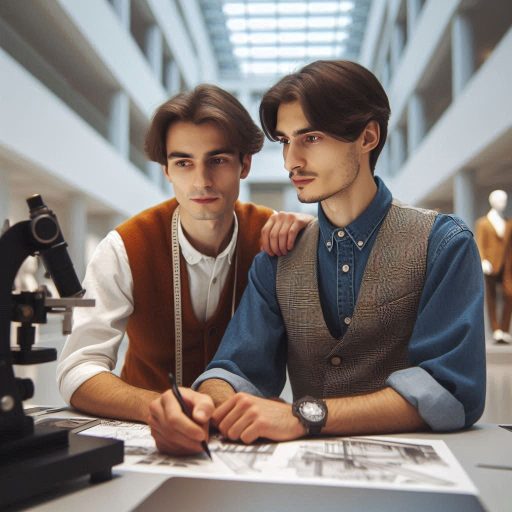Introduction
Curators and artists play essential roles in the art world.
Curators manage art collections and exhibitions.
They curate works to tell stories and convey themes.
Artists create unique pieces that express their visions and emotions.
They often challenge perceptions and provoke thought.
Collaborating with curators and artists fosters a vibrant art community.
This collaboration enhances the exhibition experience for viewers.
Curators bring expertise in organization and presentation, while artists offer fresh perspectives.
Together, they can develop innovative approaches to art curation.
Such partnerships allow curators to showcase artists‘ works effectively.
They also help artists gain visibility and recognition.
Collaborations often lead to unique exhibitions that attract diverse audiences.
When curators and artists work together, they can create transformative experiences.
The synergy between curators and artists can lead to groundbreaking projects.
These projects challenge traditional norms and explore new artistic expressions.
By working in tandem, they enrich the cultural landscape and inspire future generations.
In essence, the collaboration between curators and artists is vital for a thriving art ecosystem.
It nurtures creativity and pushes the boundaries of artistic expression.
Benefits of Collaborating with Curators
Gain Access to Curated Exhibitions and Art Shows
Collaborating with curators offers numerous benefits for artists.
Curators play a vital role in the art world.
They are experts in selecting and organizing exhibitions.
Working with them provides artists access to curated exhibitions and art shows.
This access is invaluable for showcasing one‘s artwork in a professional setting.
When artists collaborate with curators, they enter a realm of opportunities.
Curators have established networks within the art community.
They connect artists with galleries, collectors, and other professionals.
These connections help artists expand their reach.
Artists can showcase their work in prestigious exhibitions and participate in art fairs.
Increase Visibility and Exposure for Your Artwork
Visibility is crucial for any artist.
Collaborating with curators significantly increases exposure for one‘s artwork.
Curators often promote exhibitions through various channels.
They use social media, press releases, and newsletters to reach a wider audience.
This promotion allows artists to connect with potential buyers and enthusiasts.
Increased visibility leads to more sales and commissions.
Artists who work with curators find their work garners more attention.
Curators also bring expertise to the collaboration.
They understand what resonates with audiences.
Their insights help artists refine their artistic vision.
Curators provide constructive feedback on artworks.
They may suggest adjustments that enhance the overall presentation.
This collaboration leads to stronger, more impactful pieces.
Long-term Benefits of Collaboration
Moreover, collaborating with curators can open doors to future projects.
A successful exhibition often leads to further collaborations.
Curators remember artists who impress them and may invite them to participate in future shows.
This cycle of collaboration strengthens an artist‘s reputation in the art world.
Furthermore, working with curators offers educational benefits.
Curators possess knowledge of art history and trends.
Artists can learn from their expertise and gain insights into effective presentation techniques.
This knowledge can help artists improve their future exhibitions.
Learning from curators broadens an artist‘s skill set and enhances their practice.
Additionally, collaborating with curators fosters relationships with other artists.
Curators often work with multiple artists in exhibitions.
This collaboration can lead to networking opportunities.
Artists can meet and connect with peers, sharing experiences and insights.
Building a supportive community is essential for artistic growth.
In review, collaborating with curators provides significant benefits for artists.
It grants access to curated exhibitions and art shows while increasing visibility and exposure.
The expertise of curators enhances artistic practice and fosters lasting relationships within the art community.
Artists should actively seek opportunities to work with curators.
The rewards of such partnerships are well worth the effort.
Read: Freelance Character Design: How to Get Started
Building Relationships with Curators and Artists
Building relationships with curators and artists is essential for anyone interested in the art world.
These connections can lead to exciting opportunities for collaboration and growth.
Attend Art Events and Networking Opportunities
To start, attend art events and networking opportunities regularly.
These gatherings offer a unique platform to meet influential figures in the industry.
Whether it‘s an exhibition opening, gallery talk, or art fair, showing up matters.
When attending these events, prepare yourself to engage actively.
Approach curators and artists with genuine interest in their work.
Ask open-ended questions about their processes, inspirations, and experiences.
This approach fosters meaningful conversations and demonstrates your commitment to understanding their perspectives.
Listen attentively to their responses and share your thoughts when appropriate.
This back-and-forth exchange can help you stand out in their minds.
Engage in Conversations and Discussions About Art
Additionally, seek out workshops and panel discussions featuring curators and artists.
These events provide valuable insights into current trends and challenges in the art world.
Engaging in discussions during these sessions can also showcase your knowledge and enthusiasm.
Introduce yourself to speakers and ask follow-up questions after their presentations.
This proactive approach helps solidify your presence in their network.
Social media serves as another tool for building relationships.
Follow curators and artists on platforms like Instagram and Twitter.
Interact with their posts by liking, commenting, and sharing.
This online engagement keeps you connected and shows your appreciation for their work.
However, ensure your interactions remain genuine and thoughtful.
Avoid generic comments; instead, express specific thoughts about their art.
Consider volunteering for art organizations or events.
This involvement can help you meet curators and artists in a more casual setting.
You‘ll demonstrate your dedication while building valuable connections.
Working alongside professionals in the field allows for organic conversations and networking.
People appreciate collaborators who are enthusiastic and willing to contribute.
As you build these relationships, maintain consistent communication.
Send follow-up emails or messages expressing gratitude for their insights.
Share articles, exhibitions, or resources that might interest them.
This ongoing connection can solidify your place in their network and demonstrate your commitment to the art community.
Remember that building relationships takes time.
Be patient and open-minded as you engage with curators and artists.
Keep attending events, participating in discussions, and reaching out to professionals.
Over time, your efforts will create a robust network within the art world.
These relationships can lead to exciting opportunities for collaboration and personal growth in your artistic journey.
Embrace the process, and enjoy every moment as you connect with these passionate individuals.
Read: Career Paths: Becoming a Professional Character Designer
Understanding the Role of Curators in Showcasing Artwork
Curators play a crucial role in the art world.
They are the visionaries behind exhibitions.
Their work includes selecting, organizing, and presenting artworks in a way that tells a story.
This storytelling is essential for engaging the audience.
Collaborating with curators can significantly enhance the presentation of your artwork.
Curators Help in Selecting and Presenting Artworks in a Meaningful Way
Curators possess extensive knowledge of art history and contemporary trends.
They understand the nuances of different artistic movements.
This expertise allows them to select works that resonate with viewers.
By collaborating with curators, artists gain access to valuable insights.
Curators can provide feedback on how to refine your work for an exhibition.
The selection process begins with identifying themes or concepts for exhibitions.
Curators analyze potential artworks to create a cohesive narrative.
They consider how each piece interacts with others in the space.
This careful selection enhances the viewer’s experience.
It ensures that your artwork is presented in the best possible context.
Curators also focus on the physical presentation of the artwork.
They determine how to position pieces within the exhibition space.
Factors such as lighting, spacing, and flow matter significantly.
Curators work to create an environment that enhances visual impact.
Your artwork will stand out when placed thoughtfully in the exhibition.
Collaborating with Curators Can Enhance the Overall Presentation of Your Artwork
Furthermore, curators are skilled communicators.
They can articulate the significance of your work to the audience.
Through written materials and guided tours, curators share insights about each piece.
This storytelling enriches the viewer’s understanding.
It helps them appreciate the depth of your artwork.
Collaborating with curators opens up networking opportunities.
Curators often have connections with collectors, galleries, and art institutions.
These connections can lead to new opportunities for artists.
By working closely with a curator, you can increase your visibility in the art world.
Engaging with curators can also elevate your artistic practice.
They can challenge you to think critically about your work.
Curators often provide constructive feedback, encouraging growth and experimentation.
This relationship fosters a creative dialogue that benefits both parties.
In essence, understanding the role of curators is essential for artists.
Curators help select and present artworks in meaningful ways.
Collaborating with them enhances the overall presentation of your artwork.
It opens doors to new opportunities and insights.
As artists, embracing this collaboration can lead to greater recognition and success in the art world.
Read: Best Tools and Software for Character Designers

Collaborating with Artists for Inspiration and Creativity
Collaboration is a powerful tool for artists.
Working together can spark fresh ideas and new perspectives.
By exchanging ideas, artists can expand their creative horizons.
Collaboration encourages exploration beyond one‘s typical style or medium.
This journey often leads to unique and innovative artwork.
Exchange Ideas and Techniques with Fellow Artists
When artists come together, they share techniques and methods.
Each artist brings their skills, enriching the creative process.
For example, a painter might collaborate with a sculptor.
The painter’s use of color could enhance the sculptor’s work.
Conversely, the sculptor’s three-dimensional perspective might inspire the painter.
These exchanges often generate exciting dialogue and stimulate creativity.
Collaborative Projects Can Lead to Unique and Innovative Artwork
Collaborative projects encourage experimentation.
Artists can step outside their comfort zones.
They may try unfamiliar materials or adopt new approaches.
This willingness to experiment can lead to groundbreaking work.
Collaborating also allows artists to push boundaries together.
Transform Your Career Today
Unlock a personalized career strategy that drives real results. Get tailored advice and a roadmap designed just for you.
Start NowBy blending styles, they can create a fusion of ideas that challenges traditional art forms.
Participating in collaborative projects fosters a sense of community.
Artists support and inspire one another.
They motivate each other to take creative risks.
This camaraderie is essential for growth, especially in challenging artistic moments.
When faced with obstacles, having a supportive team can be invaluable.
Exhibiting collaborative artwork introduces audiences to fresh concepts.
Viewers often respond positively to innovative pieces that result from collective efforts.
These works can provoke thought and inspire further creativity.
Artists also benefit from the exposure that collaborative projects bring.
They gain access to different audiences and networks, enhancing their visibility.
Engaging with fellow artists can lead to lasting friendships and partnerships.
These relationships often evolve into regular collaborations.
Artists might discover new mentors or prot‘g‘s through these connections.
Such relationships can greatly influence their artistic journeys.
Collaborations can also take many forms.
Some artists may work together on large installations, while others might create small mixed-media pieces.
Each project reflects the unique voices of the artists involved.
This diversity of expression enriches the final work.
Online platforms have made collaboration even more accessible.
Transform Your Career Today
Unlock a personalized career strategy that drives real results. Get tailored advice and a roadmap designed just for you.
Start NowArtists can connect across distances, breaking geographical barriers.
Virtual collaborations have gained popularity, especially during recent years.
Social media allows artists to share their work, techniques, and inspirations.
Basically, collaborating with fellow artists fosters inspiration and creativity.
Read: Ceramic Art: From Hobby to Professional Career
Explore Further: Creative Director’s Guide to Project Management
Discover More: Ethical Considerations in Product Design
Learn More: Web Design for Nonprofits: Tips and Strategies
Developing a Collaborative Mindset
Collaboration enriches artistic practice and fosters creative growth.
It requires a mindset open to feedback and suggestions.
Artists and curators bring unique perspectives that can enhance your work.
By engaging with others, you expose yourself to fresh ideas and new techniques.
Be Open to Feedback and Suggestions from Curators and Artists
Being open to feedback is crucial.
Curators often have experience curating exhibitions and selecting artworks.
Their insights can help you see your work through a different lens.
Embracing constructive criticism can elevate your practice.
When you invite input from others, you challenge your creative boundaries.
This process can lead to unexpected breakthroughs.
Artists, too, contribute valuable perspectives.
Collaborating with fellow artists allows you to share techniques and strategies.
You can learn new approaches that may influence your own work.
For instance, an artist may suggest a different medium or style.
By exploring these options, you expand your artistic repertoire.
This openness to collaboration promotes experimentation and innovation.
Embrace Collaboration as a Way to Grow and Learn in Your Art Practice
Moreover, embracing collaboration fosters a sense of community.
Engaging with curators and artists creates networking opportunities.
You build relationships that can lead to future projects and exhibitions.
Such connections often result in new creative opportunities.
A strong network enhances your visibility in the art world.
Collaboration also allows for shared knowledge.
Artists can learn from each other‘s experiences, successes, and challenges.
Discussions about artistic processes can be enlightening.
Sharing resources, such as materials or techniques, can strengthen collaborative efforts.
This exchange of ideas fosters a supportive environment for growth.
To develop a collaborative mindset, actively seek out opportunities.
Attend gallery openings and artist talks.
Participate in workshops that encourage collaboration.
Engage with curators during exhibitions, asking questions about their process.
Be curious and open-minded.
Every interaction can lead to new insights.
Additionally, establish a habit of reflecting on feedback.
After receiving input, take time to consider its implications.
Ask yourself how you can integrate suggestions into your work.
This reflection can deepen your understanding of your practice.
It encourages you to evolve and refine your artistic voice.
Remember that collaboration is not just about receiving feedback.
It is also about sharing your insights.
Offer your perspective and expertise when collaborating with others.
This mutual exchange creates a balanced partnership that nurtures creativity.
In a nutshell, developing a collaborative mindset is vital for artistic growth.
Be open to feedback and suggestions from curators and artists.
Embrace collaboration as a powerful tool for learning and growth.
This approach will enhance your art practice and lead to richer creative experiences.
Promoting Your Collaborations
Collaborating with curators and artists opens new avenues for creative expression.
It allows fresh perspectives and innovative ideas to emerge.
Once you complete a project, promoting it effectively becomes crucial.
Sharing your collaborative works on social media and art platforms enhances visibility.
Share Your Collaborative Projects on Social Media
Begin by leveraging your existing social media networks.
Create posts that showcase your project‘s highlights.
Use engaging visuals to draw in your audience.
Capture the essence of the collaboration in your captions.
Share behind-the-scenes moments to create a personal connection.
This approach humanizes your work and invites viewers into your creative process.
Utilize hashtags relevant to your project.
Research popular hashtags within your art community.
This strategy helps broaden your reach and connect with like-minded individuals.
Additionally, tag collaborators in your posts.
This inclusion encourages them to share your work with their audiences.
Such interactions amplify your project‘s visibility exponentially.
Share Your Collaborative Projects on Art Platforms
Explore various art platforms to promote your collaborations.
Websites like Behance or Artsy offer excellent venues for showcasing visual art.
Create detailed profiles that highlight your collaborative projects.
Include descriptions that outline each artist’s role in the process.
Potential viewers appreciate transparency and a comprehensive understanding of your project.
Participate in online art communities.
Engage in discussions, share insights, and post your collaborative work.
Many platforms have specific groups focused on collaborations.
Joining these groups connects you with individuals who share similar interests.
This network can lead to future projects and new opportunities.
Use Collaborations as a Way to Connect with a Wider Audience
Consider hosting virtual events or live streams.
These events provide a platform to discuss your collaboration.
Invite your collaborators to join you.
Engaging in real-time conversations enhances authenticity and connection.
This strategy allows your audience to ask questions and interact directly.
Create a dedicated section on your website.
Feature your collaborative projects prominently.
Use this space to provide context and link to social media posts.
Visitors can explore your creative journey and learn about your collaborators.
Also, consider creating promotional materials.
Use flyers or digital posters to advertise your collaboration.
Distributing these in local galleries or art fairs increases awareness.
Lastly, stay consistent with your promotion efforts.
Regularly share updates about your collaborations.
Consistency keeps your audience engaged and informed.
This proactive approach fosters a deeper connection with your followers.
To sum it all up, promoting your collaborations effectively is essential for expanding your audience.
Use social media and art platforms to your advantage.
Leverage your network, engage with communities, and host events.
Every step you take brings you closer to a wider audience and new creative opportunities.
Embrace the power of collaboration, and watch your artistic impact grow.
Learn More: Wedding Floral Design: Trends and Inspirations
See Related Content: Top Concept Art Blogs and Communities to Follow
Conclusion
Collaborating with curators and artists is vital for artistic growth.
This partnership fosters creativity and innovation in the art world.
Curators provide valuable insights into audience engagement and exhibition strategies.
They help artists navigate the complexities of showcasing their work.
Artists benefit from curatorial expertise, enhancing their visibility and reach.
Collaborations can lead to unique projects that attract attention and recognition.
By working together, artists and curators create enriching experiences for audiences.
This synergy often results in memorable exhibitions that highlight diverse perspectives.
Artists should actively seek collaboration opportunities.
Engaging with curators can open doors to new venues and audiences.
Consider participating in community art events or exhibitions that emphasize collaboration.
Network with curators who share similar interests and visions.
These connections can lead to transformative experiences that elevate your artistic practice.
Embrace the potential of teamwork to explore fresh ideas and concepts.
Collaborating with curators and fellow artists can inspire you to push creative boundaries.
Take initiative and reach out; the benefits of collaboration are boundless.
Together, you can create impactful art that resonates with broader audiences.




